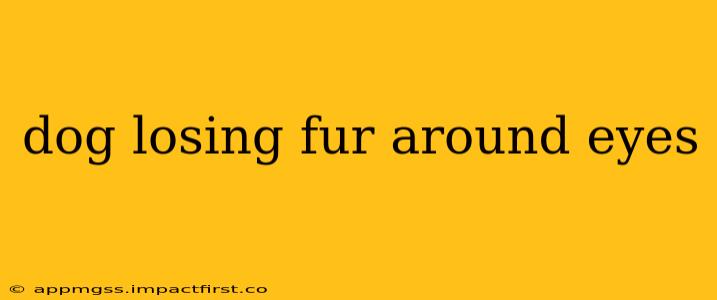Losing fur around the eyes is a common problem in dogs, and it can be alarming for pet owners. This condition, often referred to as periorbital alopecia, can stem from various underlying causes, ranging from simple allergies to more serious medical issues. This comprehensive guide will explore the potential reasons behind this hair loss, effective treatment options, and preventative measures to protect your canine companion.
Why is my dog losing fur around their eyes?
This is the most frequently asked question by concerned pet owners. Several factors can contribute to fur loss around a dog's eyes. Let's delve into the most common causes:
Allergies: A Common Culprit
Environmental allergies (like pollen, dust mites, or mold) and food allergies are frequent triggers for periorbital alopecia. These allergies often manifest as itching, redness, and inflammation around the eyes, leading to hair loss due to constant scratching and rubbing. Breeds with sensitive skin are particularly prone to this issue.
Bacterial or Fungal Infections
Bacterial infections like Staphylococcus pseudintermedius or fungal infections (like ringworm) can also cause hair loss around the eyes. These infections often present with other symptoms such as crusting, redness, and a foul odor. A veterinarian's examination is crucial for proper diagnosis and treatment.
Parasites: Fleas, Mites, and More
Fleas and mites can irritate the skin around the eyes, leading to itching, scratching, and subsequent hair loss. Careful examination of your dog's fur can often reveal the presence of these parasites.
Hormonal Imbalances
Hormonal imbalances can sometimes contribute to hair loss in dogs. Conditions like hypothyroidism (underactive thyroid) can affect the skin and coat, resulting in thinning fur, including around the eyes.
Autoimmune Diseases
In some cases, autoimmune diseases can attack the hair follicles, resulting in hair loss. These diseases are more complex and require specialized veterinary care.
Trauma or Injury
Direct trauma or injury to the eye area can also lead to fur loss. This could result from rubbing against rough surfaces, fighting with other animals, or accidental injury.
Nutritional Deficiencies
A lack of essential nutrients can sometimes manifest as poor coat health, including thinning fur around the eyes. Ensuring your dog consumes a balanced diet is essential.
How do I treat my dog's hair loss around their eyes?
Treatment depends entirely on the underlying cause. Never attempt to self-diagnose and treat your dog. A veterinary visit is crucial for accurate diagnosis and appropriate treatment. Your veterinarian may perform tests to identify the root cause, such as skin scrapings to check for parasites or fungal infections, blood tests to assess hormonal levels, or allergy testing.
Possible treatments your vet might recommend include:
- Medications: Antihistamines for allergies, antibiotics for bacterial infections, antifungals for fungal infections, and corticosteroids for inflammation.
- Topical Treatments: Medicated shampoos, creams, or ointments to address skin issues.
- Dietary Changes: Adjusting the diet to eliminate food allergens or to improve nutritional balance.
- Supplements: In some cases, supplements might be recommended to support skin and coat health.
Can I prevent my dog from losing fur around their eyes?
Prevention focuses on addressing the underlying causes:
- Regular Grooming: Brushing your dog's fur helps remove dirt, debris, and parasites.
- Healthy Diet: Feeding your dog a balanced diet rich in essential nutrients supports healthy skin and coat.
- Allergen Control: Minimizing exposure to allergens can help reduce allergic reactions.
- Parasite Prevention: Regularly using flea and tick preventatives can help control infestations.
- Regular Veterinary Checkups: Routine checkups allow for early detection of any underlying health problems.
This information is for general knowledge and does not constitute veterinary advice. Always consult with a veterinarian for diagnosis and treatment of your dog's condition. Early detection and proper treatment are vital for your dog's comfort and well-being.
